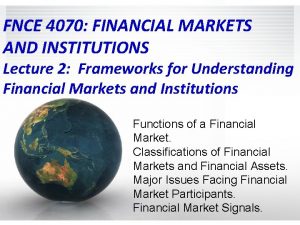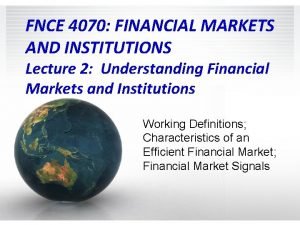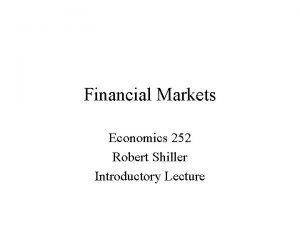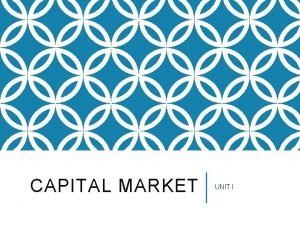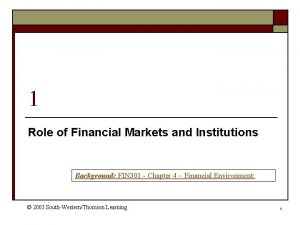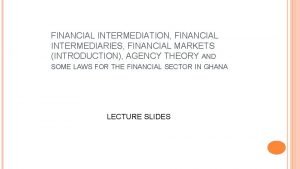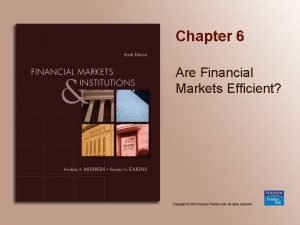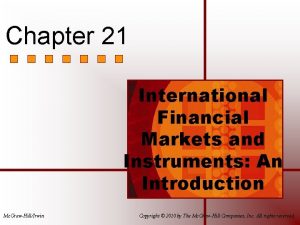Financial Markets NEXT Chapter 11 Financial Markets KEY














- Slides: 14

Financial Markets NEXT

Chapter 11: Financial Markets KEY CONCEPT • The financial system consists of institutions, such as banks, insurance markets, bond markets, and stock markets, that help transfer funds between savers and investors. WHY THE CONCEPT MATTERS • When you open a savings account, you play an important role in our economy. Your savings will be borrowed and invested by businesses and the government. The new products created by these investments help to fuel the nation’s economy. NEXT

Savings and Investment The Financial System KEY CONCEPTS • • • Savings—income not used for consumption Investment—use of income now in a way that provides a future benefit – economic investment: money lent to businesses – personal investment: individuals putting savings into financial assets Financial system—transfers funds between savers and investors NEXT

The Financial System Bringing Savings and Investment Together • People, businesses save funds; receiver issues written confirmation – confirmation called financial asset, or claim on borrower’s property • Financial market—where buyers and sellers exchange assets directly • Financial intermediary—collects funds from savers, invests in financial assets NEXT

Questions: Why are savings important to the economy? What do financial intermediaries do? What is the difference between personal and economic investment? NEXT

Financial Intermediaries KEY CONCEPTS • Includes banks and thrifts (e. g. , credit unions) – also finance companies, e. g. pension funds, life insurance companies Banks take deposits and make loans to people and businesses. Thrifts do the same as banks but pay higher interest on deposits and charge lower interest on loans. Exist to help the member. NEXT

Financial Intermediaries Example: Banking Financial Intermediaries • Provide checking, savings, money market deposit accounts, CDs – depositors earn interest – federal government insures deposits up to $250, 000 • Make loans; to make profit charge higher interest than pay depositors • Offer uninsured money market mutual funds, stocks, bonds, insurance NEXT

Other Financial Intermediaries Pensions are payments to retired employees. Sometimes, these require employee contributions. Life Insurance Companies make payments to a beneficiary when someone dies Mutual fund—pools individuals’ money to buy range of financial assets –investors own shares of entire fund that a professional manages NEXT

Financial Asset Markets KEY CONCEPTS • Financial markets categorized according to time, resalability • Capital market—for buying and selling long-term financial assets • Money market—for buying and selling short-term financial assets • Primary market—for financial assets that original buyer must redeem • Secondary market—where financial assets are resold NEXT

Questions What is the difference between a bank and a credit union? What is a pension? Who pays for a pension? Is life insurance a good idea? How do mutual funds work? NEXT

Financial Asset Markets Factor 1: Time • Capital markets—assets held for over a year – include stocks, bonds, mortgages, long-term CDs • Money markets—loans made for less than a year – include short-term CDs, Treasury bills NEXT

Financial Asset Markets Factor 2: Resalability • Primary markets—financial assets can be redeemed only by original buyer – include savings bonds, small denomination CDs – also market where first issue of stock sold through investment bankers • Secondary markets—resale markets; offer liquidity to investors – include stocks, bonds NEXT

Reviewing Key Concepts Explain the differences between the terms in each of these pairs: • capital market and money market • primary market and secondary market NEXT

Reviewing Key Concepts Use each of the three terms below in a sentence that illustrates the meaning of the term: • investment objective • Return • diversification NEXT
 X.next = x.next.next
X.next = x.next.next Why study financial markets
Why study financial markets Key partners bmc example
Key partners bmc example Key partners
Key partners Financial markets and institutions jeff madura ppt
Financial markets and institutions jeff madura ppt Classification of financial markets
Classification of financial markets Financial market classification
Financial market classification Financial markets shiller
Financial markets shiller Classification of financial markets
Classification of financial markets Classification of financial markets
Classification of financial markets Role of financial markets and institutions
Role of financial markets and institutions Financial markets and institutions ppt
Financial markets and institutions ppt Financial intermediary
Financial intermediary Are financial markets efficient
Are financial markets efficient International financial markets and instruments
International financial markets and instruments





